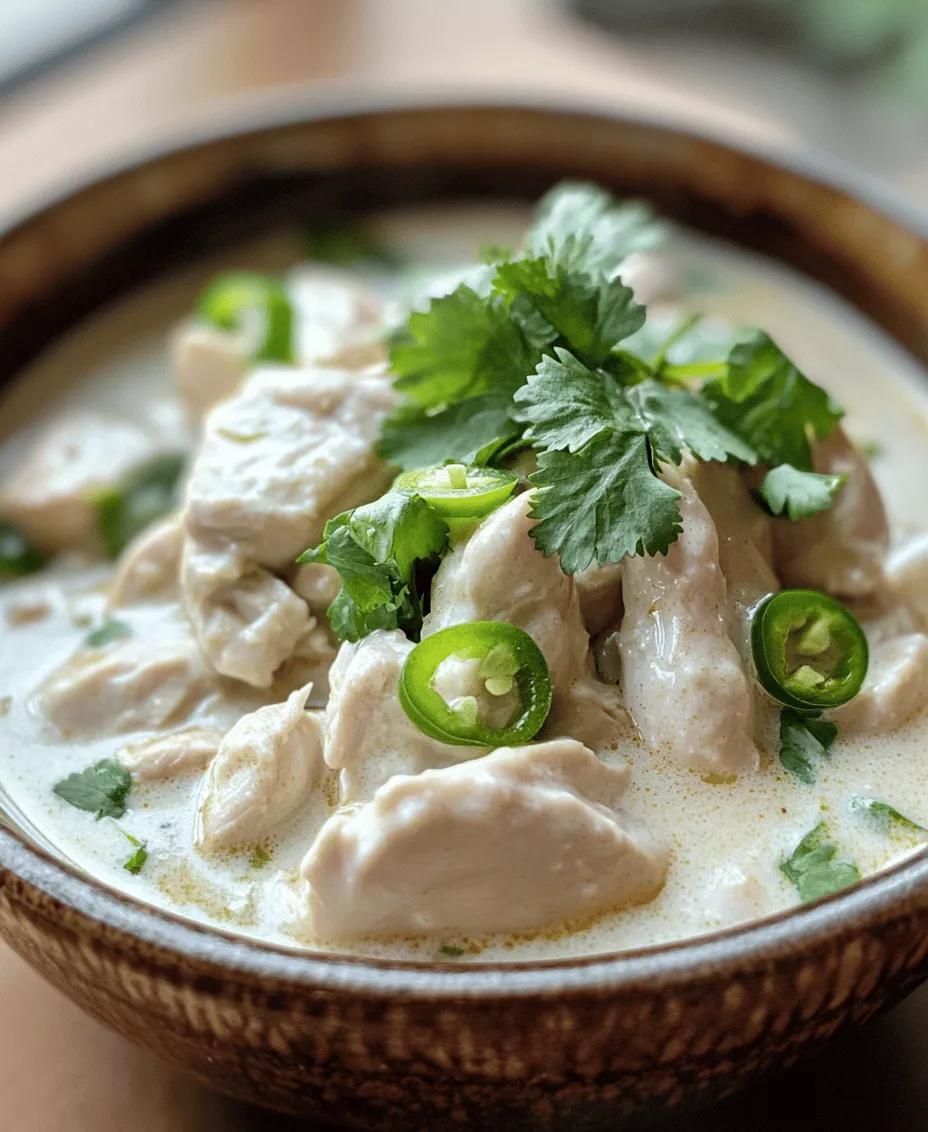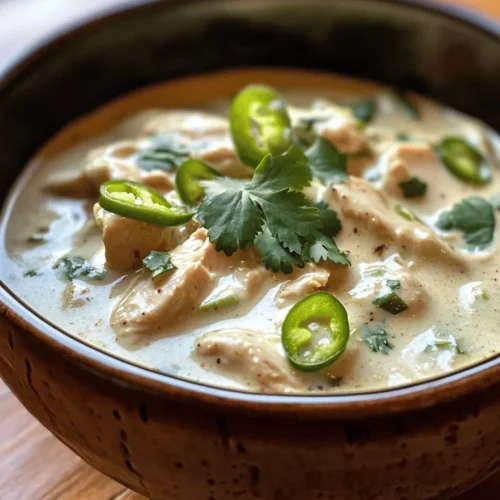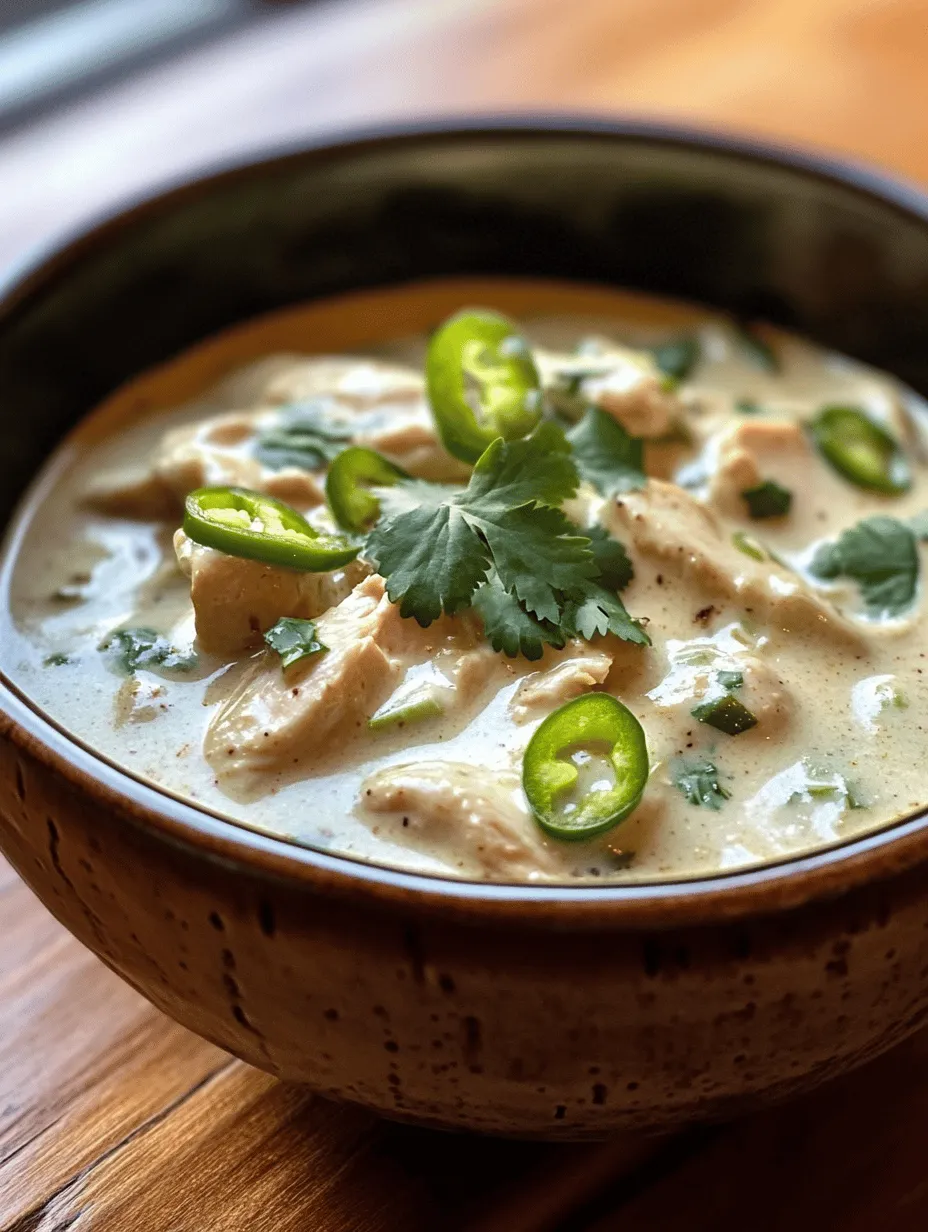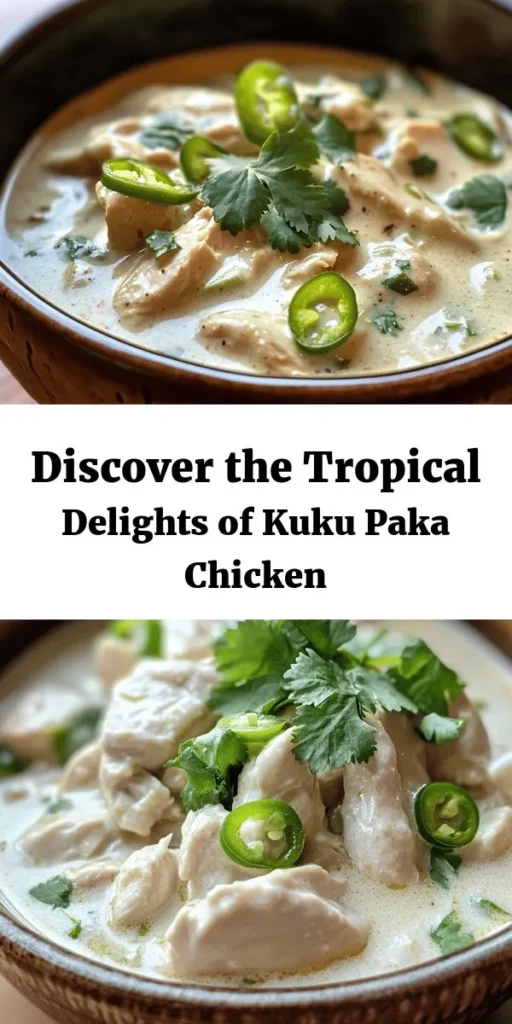Introduction to Kuku Paka: A Tropical Chicken Delight
Kuku Paka is a sumptuous dish hailing from East Africa, specifically among Swahili communities. This dish embodies the vibrant flavors of tropical cuisine, showcasing tender chicken simmered in a rich coconut milk sauce, infused with aromatic spices. Perfect for family gatherings or a cozy dinner, Kuku Paka is a celebration of culinary heritage and a delightful way to explore new tastes in your kitchen.
The harmonious blend of spices, coupled with the creamy texture of coconut milk, creates a dish that is not only comforting but also packed with layers of flavor. The origins of Kuku Paka can be traced back to the coastal regions of Kenya and Tanzania, where the Swahili culture thrives. This dish serves as a testament to the region’s rich history, influenced by various cultures including Indian, Arab, and African traditions. As you delve into the preparation of Kuku Paka, you’ll discover that it is more than just a meal; it’s a culinary experience that resonates with the diversity and history of East African cuisine.
Understanding Kuku Paka: The Cultural Significance
Exploring the Origins of Kuku Paka
The historical context of Kuku Paka is deeply rooted in the interactions between the Swahili people and other cultures along the East African coast. The dish reflects the influence of Indian spices, such as garam masala and turmeric, blended with local ingredients like coconut milk and fresh herbs. The use of coconut milk is particularly significant; it not only adds richness to the dish but also highlights the coastal geography of East Africa, where coconuts are abundantly harvested.
Kuku Paka is traditionally prepared as a communal dish, often served during family gatherings or festive occasions. This makes it a popular choice for celebrations like weddings, holidays, and community feasts. The act of sharing a meal such as Kuku Paka fosters a spirit of togetherness, allowing families and friends to bond over the shared experience of enjoying this flavorful dish.
The Role of Kuku Paka in Celebrations
In many Swahili households, Kuku Paka is more than just food; it’s a symbol of hospitality and community. The dish is often featured during significant life events, such as birthdays, holidays, and religious celebrations. Its vibrant flavors and inviting aroma create an atmosphere of warmth and welcome, making it perfect for gatherings where sharing and togetherness are paramount.
Variations of Kuku Paka can be found across different regions and communities, showcasing local ingredients and cooking techniques. While the core recipe remains consistent, some families may add their unique twist, incorporating different spices or adjusting the level of heat. This adaptability not only allows for personal expression in cooking but also highlights the dish’s versatility, making it accessible to a wide range of tastes.
Ingredients That Make Kuku Paka Special
Overview of Key Ingredients
The magic of Kuku Paka lies in its simple yet flavorful ingredients. Here’s a breakdown of the key components that contribute to this delightful dish:
– Whole Chicken: The star of Kuku Paka is undoubtedly the chicken. Opting for a whole chicken ensures a balance of flavors, as the different parts of the chicken cook at varying rates, allowing the meat to absorb the aromatic spices fully. Additionally, using a whole chicken can be more cost-effective, making it a great option for feeding a larger group.
– Coconut Milk: This creamy base enriches the flavor profile of Kuku Paka, providing a luscious texture that complements the spices beautifully. The use of coconut milk also imparts a subtle sweetness that balances the dish’s heat, making it enjoyable for all palates. When selecting coconut milk, look for options that are free from additives and preservatives for the best flavor.
– Aromatics: Ingredients like onion, garlic, and ginger are essential in building the flavor foundation of Kuku Paka. Onions add sweetness and depth, while garlic and ginger provide a warm, aromatic kick that enhances the overall taste. These aromatics should be sautéed until fragrant, setting the stage for the spices to shine.
– Spices: Kuku Paka is characterized by a robust blend of spices. Turmeric adds a golden hue and earthy flavor, while cumin and coriander provide warmth and complexity. Garam masala, often used in Indian cooking, adds a final layer of flavor that completes the dish. The careful balance of these spices is what makes Kuku Paka truly special.
– Fresh Elements: The role of lime juice and cilantro is crucial in elevating the dish’s flavor. Lime juice adds acidity and brightness, cutting through the richness of the coconut milk and chicken. Cilantro, when added at the end, brings a fresh, herbaceous note that balances the dish beautifully.
Nutritional Profile of Kuku Paka
Kuku Paka not only delivers on flavor but also offers a well-rounded nutritional profile. The main ingredients contribute various nutrients, making it a wholesome meal. Here’s a breakdown of the key nutrients found in the dish:
– Protein: Chicken is an excellent source of lean protein, essential for muscle repair and overall health. Using a whole chicken ensures that you get a range of cuts, providing varying flavors and textures.
– Healthy Fats: Coconut milk contains medium-chain triglycerides (MCTs), which are known for their health benefits, including improved metabolism and energy levels. While coconut milk is higher in calories, it provides healthy fats that can be beneficial in moderation.
– Vitamins and Minerals: Fresh ingredients like garlic, ginger, and cilantro are packed with vitamins and antioxidants, which can help support the immune system and overall well-being. Additionally, the spices used in Kuku Paka, such as turmeric, are noted for their anti-inflammatory properties.
– Dietary Considerations: Kuku Paka can easily cater to various dietary preferences. It is naturally gluten-free and dairy-free, making it suitable for those with specific dietary restrictions. For individuals following a low-carb or ketogenic diet, this dish can fit well into their meal plans due to the emphasis on protein and healthy fats.
Step-by-Step Guide to Preparing Kuku Paka
Now that we have explored the cultural significance and nutritional aspects of Kuku Paka, let’s dive into the preparation process. This step-by-step guide will help you create an authentic Kuku Paka that captures the essence of East African cuisine.
1. Gather Your Ingredients: Before you start cooking, ensure you have all your ingredients ready. This includes a whole chicken, coconut milk, onions, garlic, ginger, and your selection of spices. Having everything at hand will streamline the cooking process.
2. Prepare the Chicken: Begin by cleaning the chicken thoroughly and cutting it into pieces if desired. This will help the chicken cook more evenly and absorb the flavors of the spices better.
3. Sauté the Aromatics: In a large pot or dutch oven, heat some oil over medium heat. Add finely chopped onions and sauté until they are translucent. Next, add minced garlic and ginger, cooking until fragrant. This step is crucial as it builds the flavor base for your Kuku Paka.
4. Add the Spices: Once the aromatics are ready, it’s time to add your spices. Sprinkle in turmeric, cumin, coriander, and garam masala, stirring to coat the onions evenly. Allow the spices to toast for a minute, releasing their essential oils and enhancing their flavors.
5. Combine Chicken and Coconut Milk: Add the chicken pieces to the pot, stirring to ensure they are well coated with the aromatic mixture. Then, pour in the coconut milk, making sure the chicken is submerged in the creamy liquid. Bring the mixture to a gentle simmer, allowing the chicken to cook through and absorb the flavors.
6. Simmer and Season: Let the Kuku Paka simmer on low heat for about 30-40 minutes. This slow cooking process allows the chicken to become tender and the flavors to meld beautifully. Taste the sauce periodically, adjusting seasoning with salt and lime juice as needed.
7. Finishing Touches: Before serving, stir in freshly chopped cilantro for a burst of freshness. This final step enhances the dish, providing a vibrant contrast to the creamy sauce and rich chicken.
By following these steps, you will create a mouthwatering Kuku Paka that is sure to impress your family and friends. The combination of tender chicken in a fragrant coconut sauce is not only satisfying but also an invitation to explore the rich culinary traditions of East Africa. As we continue to explore Kuku Paka, the next sections will delve into tips for the best results and common questions to enhance your cooking experience. Stay tuned!

Marinating the Chicken: Setting the Flavor Foundation
Marinating chicken is a crucial step in the preparation of Kuku Paka. It not only enhances the tenderness of the meat but also infuses it with rich flavors that are essential to this dish’s identity. The key to a successful marinade lies in the balance of acidity, fat, and spices.
To begin, place your chicken pieces (preferably bone-in for added flavor) in a large mixing bowl. Prepare a marinade using a combination of yogurt, lemon juice, garlic, ginger, and spices like cumin, coriander, and turmeric. The yogurt acts as a tenderizer, while the acidity of the lemon juice brightens the overall flavor profile. Allow the chicken to marinate for at least 2 hours, but ideally overnight in the refrigerator. This extended marination time allows the flavors to penetrate deeply into the chicken, resulting in a tender and flavorful dish.
Sautéing the Aromatics: Building a Flavor Base
Once your chicken has marinated to perfection, it’s time to build a robust flavor base. Start by heating a generous amount of oil in a large skillet or pot over medium heat. Ghee or vegetable oil works well for this step, as they both impart a unique flavor and can withstand higher cooking temperatures.
Add finely chopped onions to the hot oil, stirring frequently until they turn golden brown. This process of sautéing onions is essential as it releases their natural sweetness, which balances the savory notes of the dish. Next, add minced garlic and grated ginger. Sauté these aromatics until they become fragrant, ensuring they do not burn, which can introduce bitterness. The combination of these ingredients creates a rich, aromatic foundation that elevates the entire dish.
Browning the Chicken: Creating Depth
Browning the marinated chicken is a pivotal step in developing the dish’s depth of flavor. After the aromatics are ready, increase the heat slightly and add the marinated chicken pieces to the pot. Avoid overcrowding the skillet; if necessary, brown the chicken in batches to achieve an even sear.
Allow the chicken to cook undisturbed for a few minutes on each side until it develops a beautiful golden-brown crust. This process not only enhances the flavor through the Maillard reaction but also contributes to the overall texture of the dish. Once browned, transfer the chicken back to a plate while you prepare the sauce, ensuring that the flavorful browned bits remain in the pot.
Incorporating Coconut Milk: The Heart of Kuku Paka
The incorporation of coconut milk is what gives Kuku Paka its signature creamy texture and tropical flavor. After browning the chicken, lower the heat and pour in a can (or about 400 ml) of full-fat coconut milk. Stir well to deglaze the pot, scraping up any browned bits stuck to the bottom. This step is crucial, as it helps to integrate the flavors developed during the browning process into the sauce.
Once the coconut milk is added, return the browned chicken to the pot, ensuring it is submerged in the creamy mixture. Allow the dish to simmer gently for about 30-40 minutes. This slow cooking process allows the chicken to absorb the rich coconut flavors while remaining juicy and tender. Adjust the heat as necessary to maintain a gentle simmer, and stir occasionally to prevent sticking.
Finishing Touches: The Role of Garam Masala
As your Kuku Paka simmers and the flavors meld together, it’s time for the finishing touch: garam masala. This essential spice blend, which typically includes cinnamon, cloves, cardamom, and nutmeg, adds a warming complexity that elevates the dish.
Add 1-2 teaspoons of garam masala to the pot in the final 10 minutes of cooking. This timing is important because garam masala is best appreciated when added towards the end, allowing its flavors to remain vibrant and aromatic. Stir well to incorporate the spices, then taste and adjust seasoning with salt and pepper as needed. This final adjustment ensures every bite is flavorful and satisfying.
Serving Suggestions for Kuku Paka
Pairing Kuku Paka with Side Dishes
Kuku Paka is traditionally served with a variety of accompaniments that enhance its rich flavors. The most common side dishes include fluffy rice and warm chapati. Both options work beautifully to soak up the delicious coconut sauce and balance the spices.
Consider serving Kuku Paka with:
– Basmati Rice: The fragrant, fluffy grains of basmati rice make a perfect companion, absorbing the coconut milk sauce and complementing the dish’s spices.
– Chapati or Naan: Soft, warm flatbreads are ideal for scooping up the chicken and sauce, providing a delightful contrast in texture.
– Vegetable Sides: Steamed or sautéed vegetables, such as green beans or spinach, add freshness and color to the plate.
– Mango Chutney: A sweet and tangy mango chutney can elevate the dish further, providing a contrasting flavor profile that enhances the overall experience.
Presentation Tips for Kuku Paka
The presentation of Kuku Paka is just as important as its flavor. To plate the dish beautifully, start by spooning a generous portion of rice or chapati onto a large serving plate. Nestle the chicken pieces atop the rice, ensuring some of the creamy coconut sauce is drizzled over the chicken.
For an added touch of elegance, garnish the dish with freshly chopped cilantro leaves and a squeeze of lime juice. The vibrant green cilantro adds a pop of color, while the acidity from the lime brightens the flavors. Serving with lime wedges on the side invites guests to customize their experience, enhancing the freshness of each bite.
Conclusion: The Joy of Enjoying Kuku Paka
Kuku Paka is more than just a meal; it is an experience that brings together rich flavors, cultural heritage, and the joy of sharing with loved ones. This tropical chicken delight embodies the essence of East African cuisine, inviting you to explore new culinary horizons. As you savor each bite, you not only indulge in a delicious dish but also participate in a tradition that celebrates community and connection.
Whether you are enjoying Kuku Paka for a family dinner, a festive gathering, or simply as a comforting weeknight meal, the vibrant flavors and creamy textures will transport you to the shores of the Indian Ocean. Embrace the experience, gather your loved ones, and allow Kuku Paka to grace your table—a dish steeped in history and flavor, sure to become a cherished favorite in your home.



